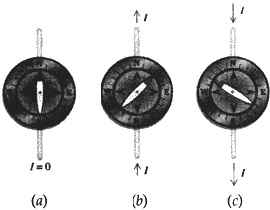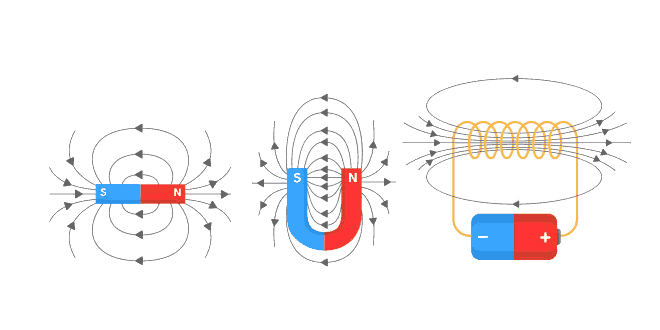Question: Horizontal component of earth’s magnetic field at a place is uniform and its direction is south to north. A high current through a horizontal power line flows at this place from west to east. Consider two points A and B at equal distances from the wire, respectively above and below it. Giving reason explain where is the field more at A or at B.
Answer: According to right hand thumb rule, the direction of magnetic field due to current at A is from north to south and at B from south to north.
Therefore, at A earth’s field and due to current are in opposite directions whereas at B they are in the same direction.
So field is more at B.
Question: A coil of insulated wire is connected to a galvanometer. Explain what happens if a bar magnet with its north pole towards one face of the coil is:
(1). moved quickly towards the coil,
(2). kept stationary inside the coil, and
(3). moved quick away from the coil?
Answer:
- The increasing magnetic field induces current in the coil as a result of which galvanometer shows momentary deflection (say towards right).
- No change in magnetic field, no induced current, deflection zero.
- Magnetic field decreases, induced current is produced in the coil and the galvanometer shows momentary deflection in opposite direction (say towards left).
Question: For the circular coil carrying current shown alongside, draw magnetic field lines. Decide which of its face behaves as north pole and which face as south pole. Give reason to justify your answer.

Answer: Front face behaves as north pole as field emerges out of it. Rear face behaves as south poles as field enters into this face.

Question: How will the magnetic field produced in a current carrying a circular coil changes, if we increase the:
(1). value of current flowing through it?
(2).distance of point P from the coil?
(3). number of turns to the coil?
Answer:
- Magnetic field will increase on increasing the value of the current.
- Magnetic field will decrease on increasing the distance from the coil.
- Magnetic field will increase on increasing the number of turns of the coil.
Question: What happens to the deflection of the compass needle placed at a point near current carrying straight conductor:
(1). if the current is increased?
(2). if the direction of current in the conductor is changed (reward)?
(3). if compass is moved away from the conductor?
Answer:
- Deflection of the compass needle increases.
- Direction of deflection in the compass needle changes.
- Deflection of the compass needle decreases.
Question: List three sources of magnetic fields.
- Magnetic field due to a bar magnet.
- Magnetic field due to a current carrying conductor.
- Magnetic field due to a current through a circular loop.
Question: Name any three factors on which the magnitude of the magnetic field due to solenoid depends.
Answer:
- Strength of current.
- Number of loops of the solenoid.
- Radius of the solenoid.
Question: State the condition for electromagnetic induction to take place. A cylindrical bar magnet is kept along the axis of a circular coil as shown in the figure. Will there be a current induced in the coil if the magnet is rotated about its axis? Discuss.

Answer:
- Condition for electromagnetic induction to take place:
(a) Either coil of a magnet should be in motion relative to each other, then there will be an induced current in the coil.
(b) If there is relative motion between a current carrying coil and a coil without current, then there will be an induced current in the second coil. - No current will be induced because there is no change in the magnetic field.
Question: Draw a diagram to show how a magnetic needle deflects when it is placed above or below a straight conductor carrying current depending on the direction of the current in the conductor.
Answer: The diagram is as shown:

Consider a wire connected to a battery in such a way that the current flows, as shown in figure. Place a compass directly over a horizontal wire as shown. The needle points north when there is no current (a). When a current is passed towards the north as shown [Fig. (a)], the needle deflects towards the east. When the current is passed towards the south as shown [Fig. (c)], the needle deflects towards the west. When the compass is placed directly below the wire, the needle deflections are reversed. Since a magnetic needle can be deflected only due to the presence of a magnetic field, therefore, it can be concluded that a magnetic field is produced around the current carrying wire.
Question: (1) Describe an activity to draw a magnetic field line outside a bar magnet from one pole to another.
(b) List any two properties of magnetic field lines.
Answer:
- Place the bar magnet NS on a sheet of paper and mark its boundary. Mark a point A near the north pole of the given magnet. Place the compass needle so that one of its ends (south) lies exactly over point A. Mark point B on the paper at the opposite (north) end of the compass needle. Move the compass needle so that the south end of the compass needle lies over B and mark point C at the north end of the needle and so on. Go on doing so till a point is reaches near the south pole of the given magnet. Join all these points with a free hand curve so as to form a smooth dotted curve.
- (i) No two magnetic field lines intersect each other.
(ii) Magnetic field lines start from the north pole and on the south pole outside the magnet.
Question: (1). Electric fuse is an important component of all domestic circuits. Why?
(2). An electric oven of rating 2 kW, 220 V is operated in domestic circuit with a current rating of 5 A. What result would you expect? Explain.
Answer:
- It is a safety device, which provides protection from fire due to short circuiting.
- The current drawn from the circuit is I = P/V = 2000/220 = 9.09 A.
This is much more than the rated value of current for the circuit, therefore, the fuse is the circuit will blow off.
Question: Name two safety measures commonly used in electric circuit and appliances, what precautions should be taken to avoid the over loading of domestic electric circuits?
Answer:
- Fuse: cuts off high current.
- Proper earthing.
Too many plugs should not be connected to the same socket.
The load should be in accordance to the rating of the fuse in the circuit.
Question: What does the direction of thumb indicate in the right hand thumb rule? In what way this rule is different from Fleming’s left hand rule?
Answer: The thumb indicates the direction of current in the straight conductor held by curled fingers, whereas the Flaming’s left hand rule gives the direction of force experienced by current carrying conductor placed in an external magnetic field.
Question: Why does a current carrying conductor kept in a magnetic field experience force? On what factors does the direction of this force depend? Name and state the rule used for determination of direction of this force.
Answer: A current carrying conductor produces a magnetic field around it, when it interacts with magnetic field, it experiences a force. Direction of force depends upon direction of current and that of magnetic field.
Fleming’s left hand rule. (For statement see above questions)
Question: Under what condition does a current carrying conductor kept in a magnetic field experience maximum force? On what other factors does the magnitude of this force depend? Name and state the rule used for determination of direction of this force.
Answer: When the conductor is held perpendicular to the magnetic field.
The magnitude of the force depends upon:
- Strength of magnetic field.
- Orientation of the conductor.
- Length of the conductor.
Fleming’s left hand rule (For statement see chap at the glance)
 Class Notes NCERT Solutions for CBSE Students
Class Notes NCERT Solutions for CBSE Students





